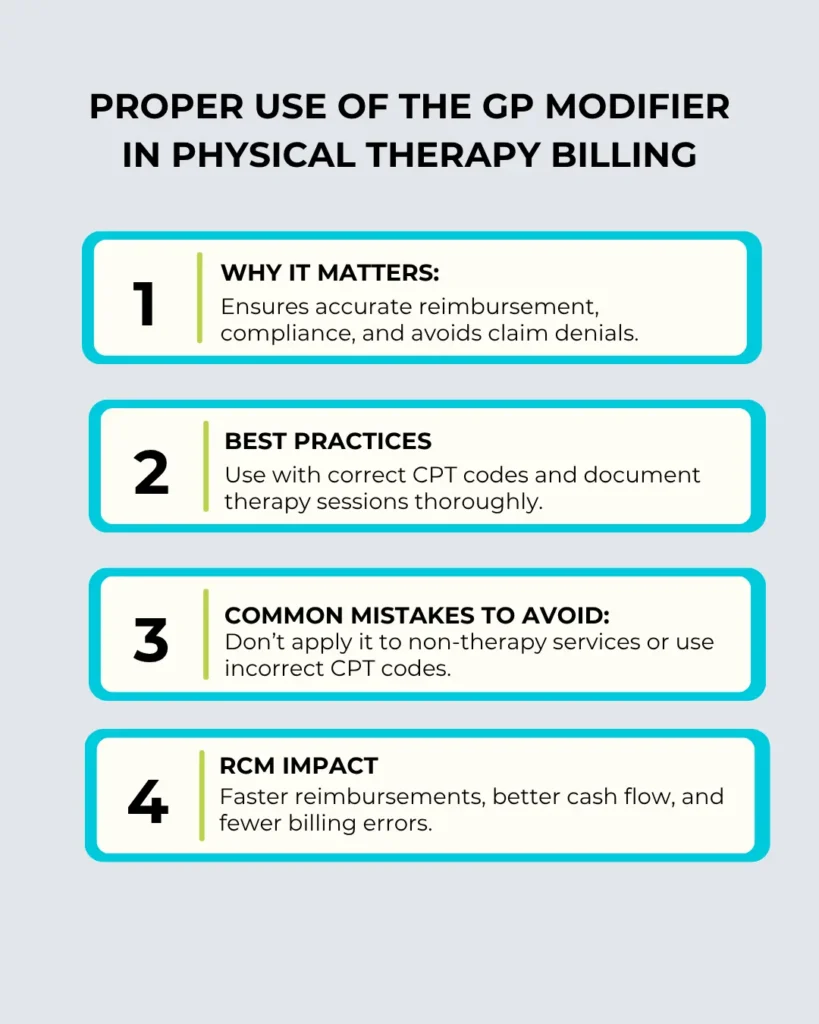Accurate billing is important for maintaining a healthy revenue cycle and avoiding claim denials for physical therapy practices. One key element in the billing process for physical therapists is the GP modifier. This modifier, used specifically for physical therapy services, plays a significant role in ensuring that you are reimbursed appropriately for the care provided.
Properly using the GP modifier can help avoid billing errors, reduce the chances of claim denials, and improve your practice’s revenue cycle management healthcare. In this guide, we will explore what the GP modifier is and why it is important for physical therapy billing. You will learn how to apply it correctly and follow best practices to ensure smooth and efficient claim processing. Ultimately, using the GP modifier will help optimize your billing process.
What is the GP Modifier?
The GP modifier is an crucial modifier in medical billing and coding that signifies that a physical therapy service was provided by a licensed physical therapist. Healthcare providers apply it to the appropriate CPT code so that Medicare, Medicaid, and private insurance companies recognize the service as physical therapy.
This modifier clarifies that a licensed physical therapist supervised or directed the service, ensuring proper coding and reimbursement. The modifier is essential for ensuring the correct identification of physical therapy services when submitting claims for reimbursement.
The GP modifier specifically indicates that the service is provided by a licensed physical therapist, which is important for establishing the correct reimbursement rates. Without it, insurance companies or Medicare may assume that the service was performed by a non-licensed provider, which could lead to incorrect payments or claim denials.
Why is the GP Modifier Important in Physical Therapy Billing?
1. Accurate Claim Submission
It is crucial for the accurate submission of claims for physical therapy services. When the GP modifier is used, it helps insurers and Medicare understand that the service was provided by a licensed physical therapist and is thus eligible for appropriate reimbursement.
Correctly applying the GP modifier ensures that your claim indicates the service was related to physical therapy and provided by an authorized professional. This prevents confusion that could lead to claim rejection or incorrect reimbursement rates.
2. Ensuring Proper Reimbursement Rates
It also ensures that physical therapy services are reimbursed at the correct rate. Medicare and many insurance companies offer different reimbursement rates for physical therapy services, and using the GP modifier helps clarify that the service was provided by a licensed physical therapist, which impacts the reimbursement amount.
Without the GP modifier, insurance companies may mistakenly reimburse physical therapy services at a lower rate or even deny the claim outright, resulting in significant revenue loss for your practice.
3. Compliance with Medicare and Other Insurers
When billing for physical therapy services, compliance with insurance policies, especially Medicare and Medicaid, is paramount. Incorrect use of modifiers or not applying the correct one can lead to compliance issues, audits, or financial penalties. The GP modifier ensures that your practice is following the correct guidelines and is compliant with reimbursement policies.
Medicare requires that physical therapy services be properly identified and associated with a licensed therapist to be eligible for reimbursement. By using the GP modifier, you guarantee compliance and prevent unnecessary legal or financial complications. Proper medical coding is essential in this process to ensure that all services are accurately documented and reimbursed correctly.
4. Avoiding Claim Denials and Delays
Incorrect billing is one of the most common reasons claims are denied. If the GP modifier is not used, the claim may be returned, requiring resubmission. This adds unnecessary time to the billing process and delays reimbursement. For practices that rely on timely payments, these delays can have a significant impact on their cash flow.

By using the GP modifier correctly, you avoid these delays, ensure that claims are processed faster, and help reduce the administrative burden on your billing team.
How to Apply the GP Modifier Correctly in Physical Therapy Billing
1. Use the GP Modifier with the Appropriate CPT Code
It is not a standalone code; it must be used in conjunction with the proper CPT code for the physical therapy services provided. Each physical therapy procedure has its own specific CPT code, such as:
- CPT code 97110 – Therapeutic exercises
- CPT code 97140 – Manual therapy techniques
- CPT code 97530 – Therapeutic activities
When submitting a claim for physical therapy services, make sure the CPT code accurately reflects the service provided, and add the GP modifier. Use this modifier whenever a licensed physical therapist delivers the service to ensure proper identification and reimbursement.
Learn more about: cpt modifiers, pt cpt codes, physical therapy procedure codes
2. Accurate Documentation
For any claim, accurate documentation is vital to support the use of the GP modifier. The documentation should reflect the following:
- The specific physical therapy service provided: Whether it was therapeutic exercise, manual therapy, or another service.
- The therapist’s involvement: Be sure to document that a licensed physical therapist provided the service and include their credentials and supervision details.
- Patient progress: Include notes on the patient’s response to the therapy and their progress.
3. Review Payer Policies Regularly
Insurance companies and Medicare have different policies on billing and the use of modifiers. It’s important to review payer policies regularly to ensure you are applying the GP modifier correctly according to each insurer’s guidelines. Staying updated on the latest rules and regulations helps ensure accurate claim processing and reduces the risk of rejections or underpayments.
4. Train Your Billing Staff
Since correct modifier usage is key to ensuring accurate claims. Training should include:
- The proper CPT codes to use in conjunction with the GP modifier.
- Detailed documentation practices.
- Understanding payer policies and how they impact billing and reimbursement.
A well-trained billing staff helps minimize errors and ensures proper reimbursement for physical therapy services.
Common Mistakes to Avoid When Using the GP Modifier
1. Applying the GP Modifier to Non-Physical Therapy Services
Use it exclusively for physical therapy services provided by a licensed therapist. Applying the modifier to other services may result in claim rejections or incorrect payments. Always verify that the service is physical therapy-related before using the GP modifier.
2. Incorrectly Pairing the GP Modifier with CPT Codes
Make sure that you are using the correct CPT code for the physical therapy service provided. Using the wrong CPT code can lead to inaccurate billing and delayed reimbursement. Always double-check the code to ensure it corresponds to the service delivered.
3. Failure to Document Therapy Sessions Properly
Without proper documentation, even the correct use of the GP modifier will not be sufficient for successful claims submission. Ensure that every therapy session is thoroughly documented, including the therapist’s involvement and patient progress.
Conclusion
The GP modifier is an important tool for ensuring accurate billing and timely reimbursement for physical therapy services. Correct application of the modifier ensures that services are identified as being provided by a licensed physical therapist, which is crucial for reimbursement accuracy.
By following the best practices outlined in this guide, you can optimize your billing process, reduce errors, and enhance your practice’s revenue cycle management (RCM). Whether you’re handling billing in-house or working with a medical billing company, understanding the GP modifier is key to ensuring your practice is reimbursed fairly for the valuable services you provide.
FAQs
Q: What is the GP modifier?
A: It is used to indicate that a physical therapy service was provided by a licensed physical therapist.
Q: Why is the GP modifier important?
A: It ensures that physical therapy services are correctly identified for reimbursement and paid at the proper rate.
Q: When should I apply the GP modifier?
A: Use the GP modifier when physical therapy services are provided by a licensed physical therapist.
Q: What happens if I don’t use the GP modifier correctly?
A: Incorrect use of the GP modifier can lead to claim denials, underpayment, or delays in reimbursement.







